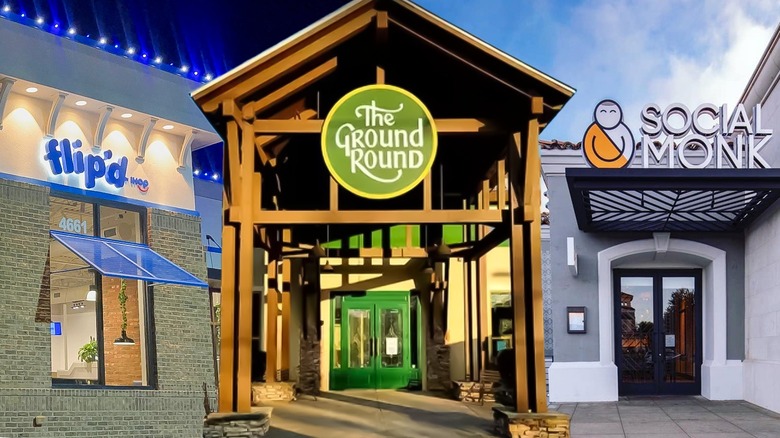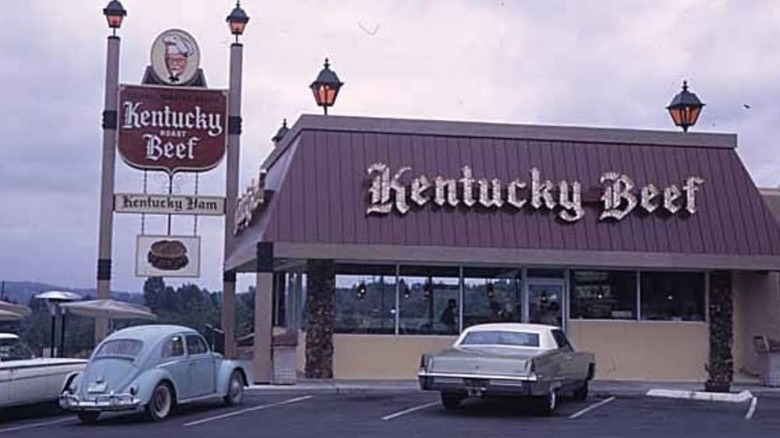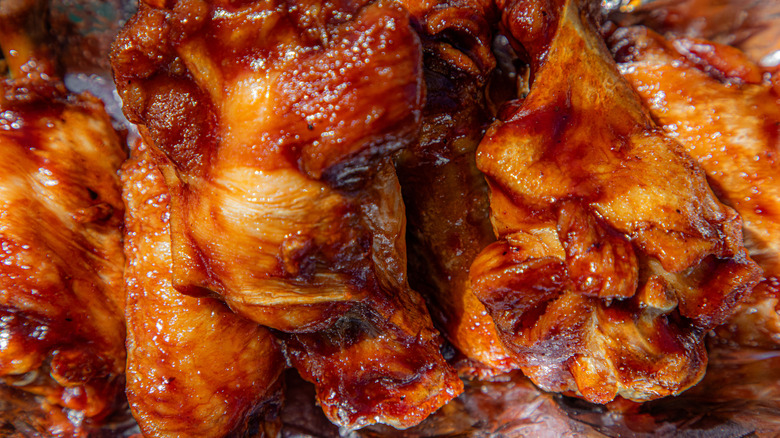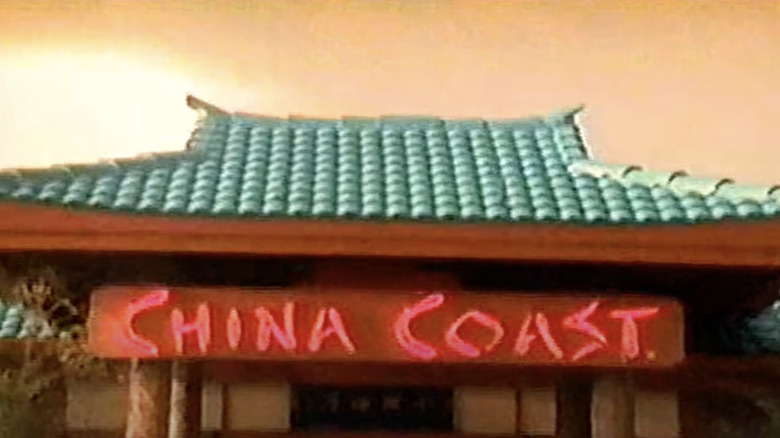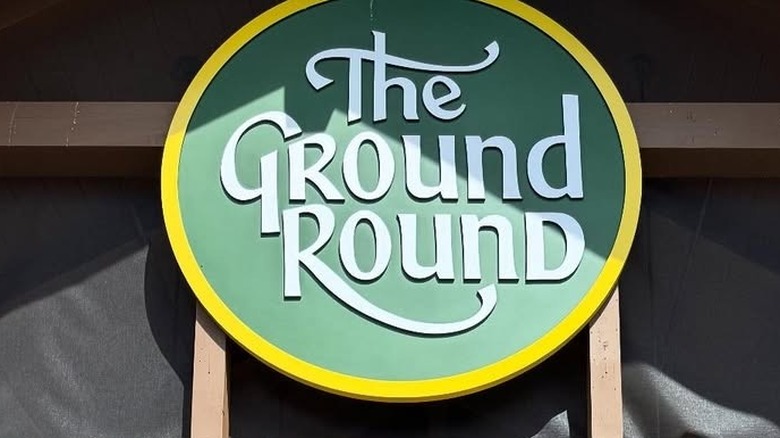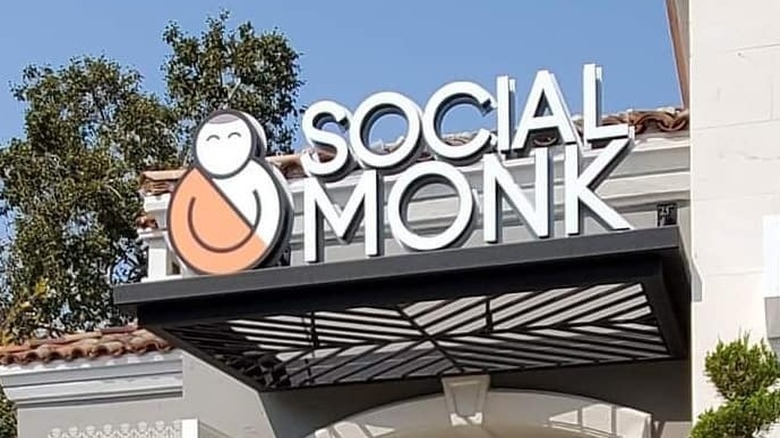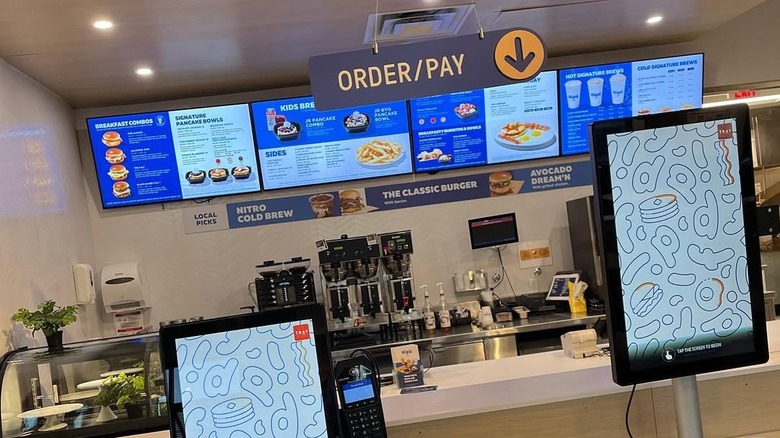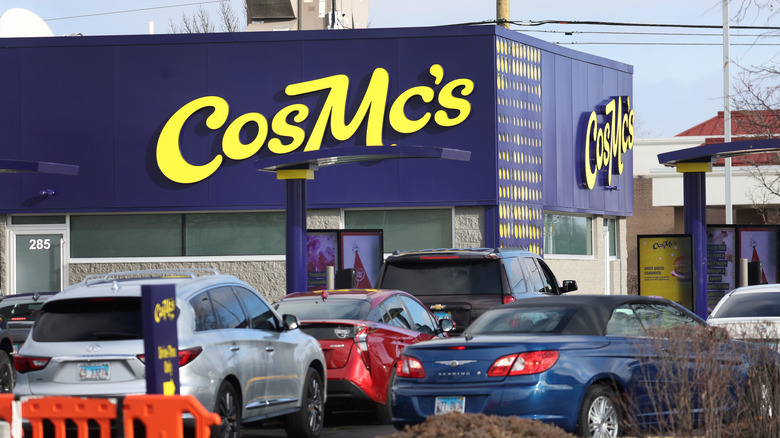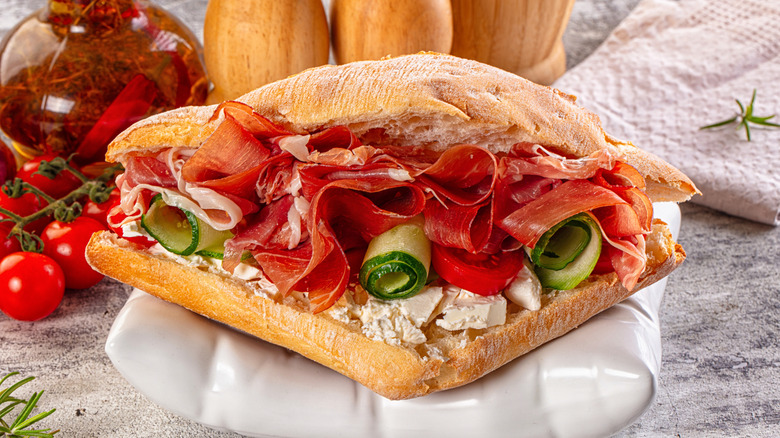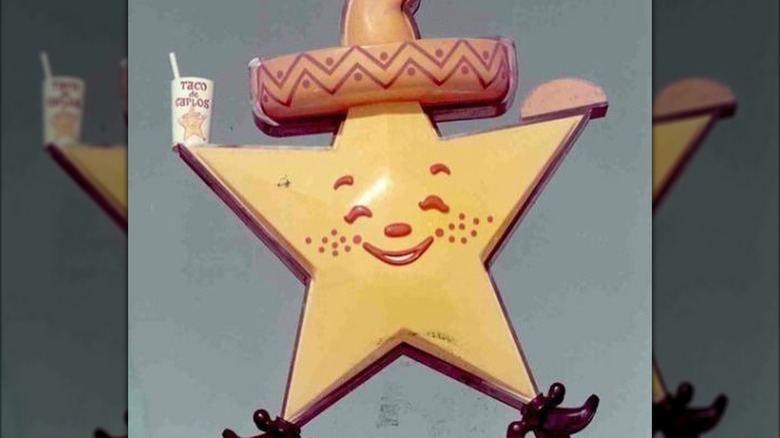Restaurant Chain Spinoffs That Flopped
Americans have been eating meals away from home for centuries, grabbing a bite in the oldest restaurants in every state or a sandwich and a cup of soup at a lunch counter, for example. It wasn't until the mid-20th century that fast food as we know it today developed, and with that, the idea of the chain restaurant. Wherever customers familiar with the brand happened to dine, they could expect the same bill of fare, and taste and quality, at a reasonable price. That method of doing business was extraordinarily lucrative for a relative handful of the fast food, quick service, and fast casual companies which became household names and permeated most every corner of the U.S. with their burgers, fried chicken, and so forth.
Those stalwarts of the restaurant industry made so much money that they expanded past their own chains, opting to launch slates of new eateries with new menus and new names. After all, they had the framework and supply chains in place, not to mention the hubris and confidence necessary, and the funding to try out such a costly endeavor. But despite those shortcuts to potential success, the offshoots faltered, quickly or eventually. Here are all the times that major American restaurant chains launched a spinoff chain that didn't capture the public's attention.
Kentucky Roast Beef and Ham
Kentucky Fried Chicken was one of the biggest rising stars in restaurants in the 1960s, with customers unable to get over the novelty of a Sunday dinner served with all of the trimmings for very little money and no arduous kitchen labor. In 1964, founder Harlan Sanders sold Kentucky Fried Chicken to a group led by John Y. Brown, which by the end of the decade had grown the chain from 600 units. The popularity of fast food chicken in the late 1960s inspired competitors like Church's Chicken and Chick-Fil-A, so KFC tried to offer customers something extra, introducing roast beef sandwiches to the menu.
While that menu item wasn't particularly popular at pre-existing Kentucky Fried Chicken stores — one cost 79 cents on its own, versus 85 cents for a two-piece chicken meal with a side and a biscuit — Brown used it as the basis for a diversification project. In 1969, about 100 Kentucky Roast Beef restaurants opened. It prepared homestyle meals like its chicken-based sibling, just with different centerpiece meals: slow-cooked beef, as well as ham. Within a couple of years, every free-standing Kentucky Roast Beef restaurant had disappeared, while the sandwiches remained on the menu at Kentucky Fried Chickens here and there, at the behest of individual franchisees.
King Neptune's Seafood Galley from Burger Queen
A once popular restaurant chain that now barely exists, Burger Queen was a major fast food concern of the 1960s and 1970s. Serving mostly burgers and shakes, Burger Queen squared off against Dairy Queen, both with a similar name and in its business model of opening shops in smaller, under-served American towns. In the 1970s, the nearly 200-location Burger Queen joined the fast food fish fad, offering a fish and chips platter to compete with the then-growing but now struggling and re-emergent seafood chain Long John Silver's as well as Burger King's Whaler and McDonald's Filet-O-Fish.
Burger Queen's off-brand gambit worked so well that the company took the plunge and created a completely separate fish joint. The first King Neptune's Seafood Galley opened for business in May 1976. It didn't get much farther than that one test location, but its simple fried fish dishes remained part of the Burger Queen menu, even after it evolved into Druther's, which is now just one restaurant in Kentucky.
Hickory Bell from Taco Bell
Taco Bell isn't named after the bell imagery on its Mission-style buildings; it was created by Southern California restaurateur Glen Bell. After the less successful lives of Taco Tia and Bell's Drive-In, he gave Taco Bell a try, helping to introduce Mexican-inspired cuisine to Americans and expanding the palate of fast food in general. Taco Bell grew rapidly, going from one location in 1962 to franchising in 1964, to 325 by 1970, serving a limited menu of tacos, tostadas, burritos, and refried beans.
So emboldened by the quick and lucrative success of Taco Bell, Glen Bell figured he could make barbecue into a viable and eponymous fast food concept as well. In early 1970, he announced the launch of Hickory Bell, billed at the time as "a Western barbecue style restaurant," according to LA Weekly. Existing Taco Bell franchisees were offered first crack at their own Hickory Bell, but only a few accepted the chance. Fewer than five Hickory Bells opened in and around Los Angeles, including one that existed inside of a Taco Bell. It flopped, and Taco Bell got out of the barbecue game for good.
China Coast from Olive Garden
General Mills's dining division, later known as Darden Restaurants, did so well with streamlined versions of Italian cuisine and seafood with Olive Garden and Red Lobster, respectively, that in 1990, it established what was one of the first full-service Chinese-American restaurant chains. While such cuisine was already hyper-familiar to many Americans thanks to countless independent and family-run Chinese restaurants, China Coast was eager to familiarize patrons with numerous Asian cuisines that it probably overly westernized. Cutlery was presented along with chopsticks, and guests were treated to the entirely invented China Coast Bread. Customers could eat familiar Chinese-American dishes as well as things like fries, ribs, and chocolate brownies.
A multi-unit rollout in the Orlando area was well-received enough to lead to national expansion, and by 1995 China Coast was a 51-location chain. That's when Darden opted to close down the Asian-oriented spinoff, citing an inability to lure customers away from their favorite Chinese restaurants. The company was losing $7 million every three months on the venture.
The Ground Round from Howard Johnson's
Before fast food spots clustered near freeway exits, the place to dine out in the middle of a road trip or a long-haul drive was Howard Johnson's. The orange-roofed restaurant chain was the United States' biggest restaurant chain in the 1960s, with its diners selling scores of simple burgers, orders of fried clams, and ice cream. Its hundreds of diners were so profitable that in 1969, Howard Johnson's created another chain called The Ground Round. Simultaneously a little bit fancier and a lot more broadly family-friendly than its predecessor, The Ground Round offered sandwich and burger platters and other items that would now be called American pub favorites. Along with handing out free popcorn and peanuts, the restaurants kept the kids happy by allowing mascot Bingo the Clown to wander around the premises, and screening cartoons.
While moderately successful, The Ground Round never approached the economic or cultural saturation of Howard Johnson's. After peaking with 215 locations in the late 1980s, it started to disappear. Other casual dining chains that took inspiration from The Ground Round, like Chili's and Applebees, eclipsed the dying restaurant business as it rapidly closed locations in the 1990s and beyond. Two 21st century attempts to reboot The Ground Round as a sports bar didn't pan out, and as of early 2025, only four remained open.
Social Monk Asian Kitchen from Cheesecake Factory
The famously large menu at The Cheesecake Factory apparently wasn't big enough to contain the fast casual dining chain's ambitions. Not content with serving towering cheesecakes and familiar versions of nearly every style of cuisine popular in the modern United States, The Cheesecake Factory unveiled a broadly Asian-themed restaurant in February 2019. Launching in Calabasas Hills, California, the first Social Monk Asian Kitchen operated with a menu that featured dishes historically linked to China, Indonesia, Singapore, Vietnam, Thailand, and Malaysia. The through-line, according to a press release: "fresh ingredients, exotic spices, and bold flavors." Social Monk Asian Kitchen's logo: a simplified, cartoon depiction of a meditating monk.
Far outside of its wheelhouse with an expansive selection of items that aimed for authenticity, Cheesecake Factory couldn't keep Social Monk Asian Kitchen afloat forever. It closed the place down in 2024, never expanding from that pilot location.
Flip'd by IHOP
Formerly known as the International House of Pancakes, the somewhat dated breakfast and diner food chain was in need of a revamp by the 2010s. By that point exclusively going by IHOP, the company briefly renamed itself IHOb (the "b" was for "burgers") as a publicity stunt in 2018, and then tried to position itself as a hip, low-key dining option with a miniature offshoot chain. In 2021, the first Flip'd started serving pancakes in Lawrence, Kansas, with a restaurant in New York opened a few months later, followed by outlets in Silver Spring, Maryland, and Cincinnati.
Created to help franchisees expand into urban and suburban areas, a Flip'd restaurant took up less space than a regular IHOP and required just a skeleton crew to make a limited menu of ready-to-eat and portable foods like pancake bowls, breakfast sandwiches, and burgers. Limited dine-in space was provided, as Flip'd aimed to primarily operate as a takeout joint.
In June 2023, IHOP abruptly closed three of its four Flip'd stores, announcing that it had grounded the pilot program but would use some aspects of the spinoff in its traditional eateries. The final Flip'd in Cincinnati was converted into an IHOP.
CosMc's from McDonald's
McDonald's shiny spinoff restaurant CosMc's hit the scene in 2023, with a tentatively launched opening in Bolingbrook, Illinois, preceding the debut of a few more as part of a slow and soft launch of the beverage outlet. Clearly an outgrowth of the aggressively marketed McCafé line of coffees and other premium beverages available at its thousands of other stores, McDonald's similarly created CosMc's to take on Starbucks. CosMc's adopted a retro-futuristic space theme, selling "otherworldly beverage creations" intended to send a customer's "mood into the stratosphere," according to a McDonald's press release.
CosMc's sold a few McDonald's items, like the Egg McMuffin, the McFlurry, and soft serve ice cream cones, along with newly developed breakfast sandwiches, snacks, and desserts to complement an array of coffees, juices, and cold blends. Stuff like boba, special syrups, and energy shots could be added to the likes of the S'mores Cold Brew, Churro Frappé, or Berry Hibiscus Sour-Ade.
The chain only ever got as big as five outlets. After only 17 months in existence, McDonald's closed down the entire enterprise. Corporate executives announced in May 2025 that they'd only spun off CosMc's to reduce the theoretical increased labor load on employees tasked with customizing McCafé orders. So few CosMc's customers amended their drinks that it became clear to McDonald's that the spinoff wouldn't be economically feasible for long.
Aussie Grill from Outback Steakhouse
The signature fried appetizer at the Australian-themed sit-down restaurant chain Outback Steakhouse, the Bloomin' Onion, inspired the name of the eatery's parent company, Bloomin' Brands. That just shows how important Outback is to its corporate office, which so thoroughly believed in the brand and the popularity of its food that it thought it could stand on its own, apart from the onsite dining experience. In 2020, Bloomin' Brands opened an Aussie Grill in Lutz, Florida, a drive-through-only restaurant with a menu consisting of Outback Steakhouse's greatest hits. While that event coincided with the COVID-19 pandemic, and a shift to takeout for restaurants looking to weather public space shutdowns, plans for Aussie Grill had been in place well before the coronavirus.
Outback Steakhouse spawned a total of eight takeaway-based Aussie Grills, mostly in Bloomin' Brands' home state of Florida. Response was so poor that by February 2025, all but two had shut down entirely. Those grab-and-go-oriented spots stayed open at a football stadium and on a college campus.
JBX Grill from Jack in the Box
Well established as the place to go for budget burgers, fries, and tacos with a cult following, Jack in the Box briefly rebranded itself as the slightly more high-end Monterey Jack's in the mid-1980s. The idea lost the company so much money that it converted all locations back to original-flavor Jack in the Box outlets and put away for 20 years the notion of attracting a higher-income clientele. In 2004 and 2005, Jack in the Box tested out a new restaurant concept called JBX Grill. Evoking and imitating the fast-casual dining atmospheres emerging around the U.S. at the time, dining rooms eschewed the bright and plastic fast food look in favor of wood floors, fireplaces, and big, comfy chairs. On the menu: hamburgers, but also artfully conceived ciabatta sandwiches stuffed with carne asada and Greek chicken, and Thai and poblano-lime salads. Two initial JBX Grill locations in San Diego did solid enough business that Jack in the Box expanded the spinoff to nine restaurants centered in the Boise, Idaho, and Bakersfield, California metropolitan areas.
Traffic to the JBX Grill outposts wasn't enough to justify the $400,000 it took to convert a single Jack in the Box, and in 2005, with the experiment cutting into the parent company's profits, the test was canceled. All the JBX Grills became normal Jack in the Box restaurants.
Carl's Whistle Stop from Carl's Jr.
Carl Karcher is objectively one of the most successful people in fast food history. He opened a hot dog stand in Los Angeles in 1941, which turned into four in four years, prompting the opening of Carl's Drive-In Barbecue in nearby Anaheim. Its signature item was a charbroiled hamburger, which Karcher started selling at an offshoot called Carl's Jr., because the restaurant was smaller than his drive-in. That became one of the many fast food chains to originate in Southern California, along with Jack in the Box, Taco Bell, and the modern incarnation of McDonald's. But while Carl's Jr. represented one successful restaurant spinoff, a spinoff of that spinoff failed to get going.
In the 1960s, Karcher opened three Carl's Whistle Stops, one of the strangest old-school restaurants to ever exist. A casual, sit-down restaurant, it still involved rapid service by utilizing the business's theme. Carl's Whistle Stop was train-oriented, and toy trains physically brought order tickets back to the kitchen. More specifically, the chain harkened back to the 1930s era of railway travel, as the staff dressed like railroad employees and they served menu items like "Hobo Burgers." By 1970, the idea had gone off the rails, and all three Carl's Whistle Stop restaurants had shut down.
Taco de Carlos from Carl's Jr.
In the 1970s, Mexican-style fast food experienced explosive growth out of Southern California, which incubated chains like Taco Bell and Pup 'n' Taco. Carl's Jr. had opened 100 locations in the region by then, and Carl Karcher, founder and leader of the burger-based restaurant, wanted in on Mexican-inspired fast food. For about a decade, Carl's Jr. operated the subsidiary Taco de Carlos.
Carl's Jr. openly marketed its Mexican food purveyor as a branch of the parent company, utilizing the former's smiling star logo for the latter, albeit topped with a sombrero. "Carlos" is also the Spanish version of "Carl," and many Taco de Carlos locations were built next to extant Carl's Jr. hamburger restaurants. The food was a bit different and more elaborate than what Southern Californians could find at Taco Bell, as the chain's signature was the California Burrito – a chimichanga (one of the unhealthiest things to order at Mexican restaurant) stuffed with taco meat, cheese, and green chilis. Be that as it may, Taco de Carlos had a hard time competing with the many authentic Mexican food restaurants doing business in California for decades. Karcher got rid of all 17 Taco de Carlos stores in the early 1980s.
